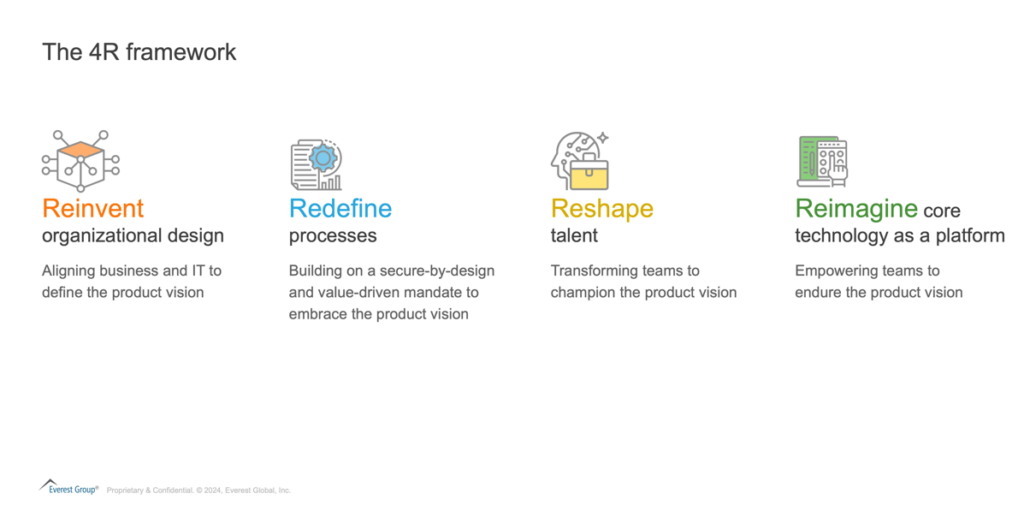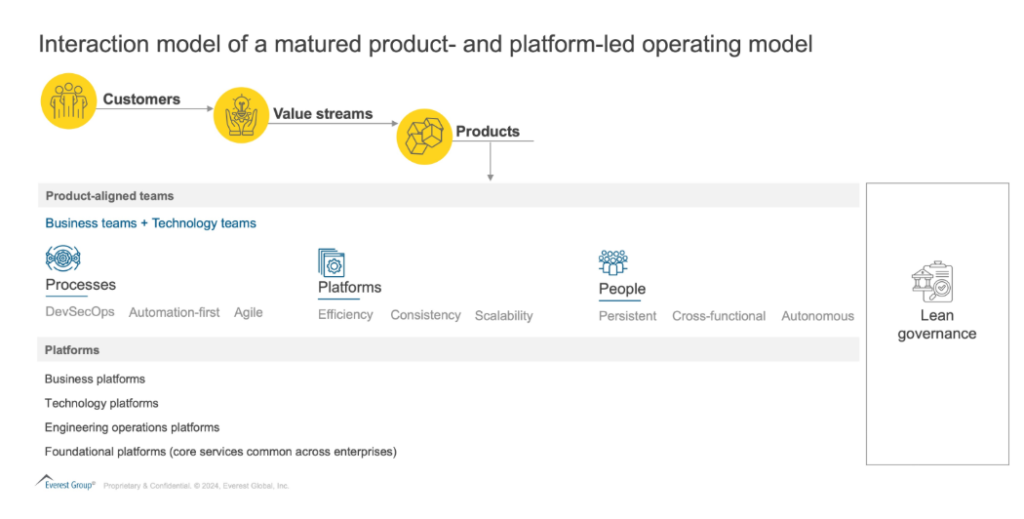Blog
Product-Led Transformation: Four Strategies to Outmaneuver Your Competition

Welcome to the second blog in our series on transitioning to the Product-Led Operating Model (PLOM). In the first installment, we discussed the strategic imperative for organizations to adopt PLOM, and why traditional operating models may no longer serve the fast-paced, customer-driven market. If you missed it, you can read it here.
In this blog, we take a deep dive into the 4Rs — Reinvent organizational design, Redefine processes, Reshape talent, and Reimagine core technology components — that form the backbone of a successful PLOM transformation.
Reach out to discuss this topic in depth.

Together, these pillars create a comprehensive framework for aligning teams, processes, and technologies with a unified product vision. Let’s explore each dimension and uncover how enterprises can build a more agile, customer-centric organization.
Reinvent organizational design: break down silos, build agility
A product-led transformation starts with rethinking organizational structures. Traditional hierarchies and functional silos stifle agility, innovation, and collaboration. To overcome these challenges, enterprises must align teams with business value streams — shifting from a technology-focused setup to a product-centric model.
Key considerations:
- Empowered, cross-functional teams: Establish product teams that blend business and IT expertise, creating accountability for both revenue generation and innovation. Models like Spotify’s squads and tribes offer excellent templates
- Clear roles and accountability: Define responsibilities such as product owners, agile coaches, and chapter leads to drive focus and clarity
- Generative culture: Foster a culture where teams are encouraged to innovate, fail fast, and continuously improve
Organizations that embrace alignment-enabled autonomy—where teams have the freedom to make decisions but stay aligned with overarching goals—experience better collaboration and faster decision-making. This approach positions enterprises to respond swiftly to market changes.

This exhibit illustrates the core structure of a product-aligned operating model that integrates business and technology teams, to deliver value through well-defined value streams. It emphasizes the role of persistent, cross-functional, and autonomous teams, supported by lean processes like Agile, DevSecOps, and automation-first approaches. The model is underpinned by robust platforms (business, technology, and foundational) that ensure efficiency, scalability, and consistency, governed by a lean framework for agile decision-making.
Redefine processes: from linear to agile
Processes define how work gets done, and outdated, linear project-based approaches can no longer keep up with today’s demands. Enterprises must adopt agile and DevSecOps methodologies to enable continuous product delivery and innovation
Key process shifts include:
- From projects to products: Replace project-based management with iterative, product-focused delivery cycles
- Integrated security and compliance: Incorporate security into the development process (DevSecOps) rather than treating it as an afterthought
- Outcome-driven metrics: Shift from measuring outputs (e.g., number of features delivered) to outcomes (e.g., customer satisfaction, time-to-market)
By adopting a lean product development mindset, organizations can reduce lead times, improve responsiveness, and ensure processes remain customer focused. Furthermore, OKRs (Objectives and Key Results) can help align teams with business goals and track progress effectively.
Reshape talent: from specialists to product champions
The success of a PLOM depends heavily on the people who execute it. Traditional role definitions and rigid expertise boundaries must evolve to create a dynamic workforce equipped for product-centric delivery.
Transformational steps:
- Upskilling and cross-training: Equip employees with skills beyond their immediate technical domain, enabling them to contribute to broader business outcomes
- Cross-functional collaboration: Encourage collaboration between business and IT professionals, fostering shared accountability for product success
- Talent deployment models: Implement flexible talent pools (e.g., chapters and guilds) to dynamically allocate resources based on evolving business needs
Reshaping talent not only empowers employees but also increases engagement. When individuals see the direct impact of their work on customer outcomes, it creates a culture of ownership and innovation.
Reimagine core technology: your strategic battlefield, not just infrastructure
A product-led operating model requires a robust and modern technology foundation. Legacy systems and fragmented tech stacks can undermine even the most well-designed models. Enterprises need to rethink their technology infrastructure to enable agility, scalability, and speed.
Core technology initiatives:
- API-first architecture: Enable seamless integration and interaction between systems, allowing product teams to access infrastructure and data efficiently
- Cloud-native solutions: Transition to scalable, cloud-based platforms that support rapid development and deployment
- Low-code/no-code platforms: Empower business teams to build and iterate on solutions without heavy reliance on IT resources
- Data-backed decision-making: Centralize analytics to provide teams with real-time insights for better decision-making
By reimagining technology as a platform rather than a collection of tools, enterprises can create an environment where innovation thrives. A modern tech stack also ensures consistency, reduces costs, and accelerates time-to-market.
Looking ahead: learning from pioneers
As enterprises embark on their PLOM journeys, the 4Rs offer a comprehensive framework to navigate the complexities of transformation. However, each organization’s path will be unique, influenced by its industry, size, and strategic objectives.
While this blog has explored the foundational pillars, the next in our series will reveal key insights from enterprises that have successfully adopted PLOM.
Based on Everest Group’s survey of 200 global enterprises, we will uncover the challenges, lessons, and tangible benefits experienced by leaders in this space.
Stay tuned as we bring you the perspectives and learnings from these pioneers to help you refine your approach to PLOM and set your organization up for success.
If you found this blog interesting, check out our blog focusing on Mid-market Enterprises: The New Frontier For Digital Transformation Services | Blog – Everest Group, which delves deeper into another topic covered by the Engineering & Information Tech service line.
If you have any questions, would like to gain expertise regarding PLOM, contact Krishna Zawar ([email protected]), Alisha Mittal ([email protected]), Parul Trivedi ([email protected]), Ankit Nath ([email protected]) or Lalith Kumar ([email protected]).